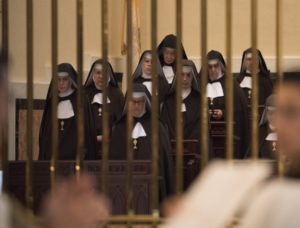 On the website Where Peter Is, there is a recent article on the implementation of the guidelines/instructions contained within Vultum Dei Quaerere and Cor Orans. In the article, called “Contemplative Nuns Speak for Themselves,” they cite the Institute on Religious Life and the series of articles we have been doing on the same topic. The IRL articles have been written by our National Director, Fr. Thomas Nelson, O.Praem, as well as by the nuns themselves. So far, we have heard from the Passionists and the Carmelites with the Poor Clares and the Visitation nuns yet to come. To read the articles: go to the CloisteredLife.com website, resources page (middle of page), and click on the VDQ CO articles.
On the website Where Peter Is, there is a recent article on the implementation of the guidelines/instructions contained within Vultum Dei Quaerere and Cor Orans. In the article, called “Contemplative Nuns Speak for Themselves,” they cite the Institute on Religious Life and the series of articles we have been doing on the same topic. The IRL articles have been written by our National Director, Fr. Thomas Nelson, O.Praem, as well as by the nuns themselves. So far, we have heard from the Passionists and the Carmelites with the Poor Clares and the Visitation nuns yet to come. To read the articles: go to the CloisteredLife.com website, resources page (middle of page), and click on the VDQ CO articles.
As it says in the Where Peter Is article: “At the same time that Fr. Nelson was planning the IRL’s series of articles, a similar, but much smaller, initiative began in the shape of a new website, Seeking the Face of God. This is a website “About Contemplative Nuns By Contemplative Nuns.” It was established by our friend Sr. Gabriela of the Incarnation, OCD, a Carmelite nun and a regular contributor to Where Peter Is.” This is another resource for VDQ CO information.
More from Where Peter Is:
On May 15, 2018, the Vatican announced the promulgation of Cor Orans, the document containing the directives for communities of contemplative nuns around the world. In the years that followed, few Catholic websites in the United States have given a platform for contemplative communities who want to follow the Vatican’s directives to share their perspectives. Where Peter Is has covered Cor Orans and has provided a window into how some of the subsequent issues and controversies have affected these communities. You can find our series of articles here.
